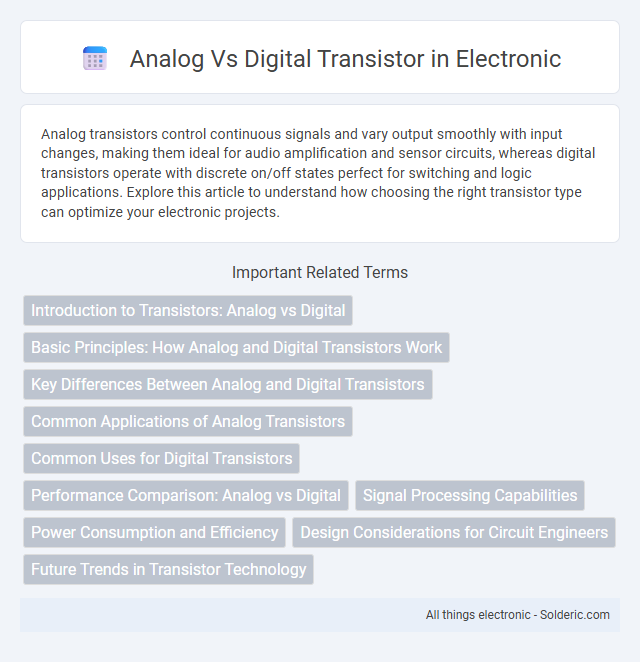Analog transistors control continuous signals and vary output smoothly with input changes, making them ideal for audio amplification and sensor circuits, whereas digital transistors operate with discrete on/off states perfect for switching and logic applications. Explore this article to understand how choosing the right transistor type can optimize your electronic projects.
Comparison Table
| Feature | Analog Transistor | Digital Transistor |
|---|---|---|
| Definition | Transistor used for continuous signal amplification and processing. | Transistor integrated with resistors for switching digital signals. |
| Signal Type | Analog signals (continuous voltage/current). | Digital signals (binary ON/OFF states). |
| Function | Amplifies or modulates analog signals. | Used as a switch in digital circuits. |
| Integration | Standalone transistor component. | Transistor with built-in biasing resistors. |
| Applications | Audio amplifiers, RF amplifiers, analog circuits. | Logic circuits, switching regulators, microcontroller interfaces. |
| Complexity | Requires external resistors and biasing. | Ready to use, simplified circuit design. |
| Speed | Varies, dependent on analog characteristics. | Fast switching suitable for digital operations. |
Introduction to Transistors: Analog vs Digital
Transistors serve as fundamental components in electronic circuits, with analog transistors managing continuous signal variations and digital transistors operating within binary states of on and off. Analog transistors, such as bipolar junction transistors (BJTs) and field-effect transistors (FETs), amplify and modulate analog signals for applications like audio processing and sensor interfacing. Digital transistors, integrated into logic gates and microprocessors, switch rapidly between saturation and cutoff states to represent binary data in computing and digital communications.
Basic Principles: How Analog and Digital Transistors Work
Analog transistors operate by controlling continuous voltage or current levels to amplify or modulate signals, relying on the transistor's ability to vary resistance smoothly within its active region. Digital transistors function as binary switches, rapidly toggling between saturation (fully on) and cutoff (fully off) states to represent logical high and low levels. The fundamental difference lies in analog transistors emphasizing linear response for signal fidelity, whereas digital transistors focus on switching speed and precise threshold control for digital logic circuits.
Key Differences Between Analog and Digital Transistors
Analog transistors operate continuously over a range of input signals, providing variable amplification or modulation, while digital transistors function as switches with binary on/off states in digital circuits. Key differences include analog transistors' linear operation for signal amplification versus digital transistors' saturation and cutoff states optimized for logic level switching. Analog types are often used in amplifiers and signal processing, whereas digital transistors are integral to microprocessors, logic gates, and digital signal processing.
Common Applications of Analog Transistors
Analog transistors are widely used in amplification circuits, such as audio amplifiers, radio frequency amplifiers, and voltage regulators, due to their ability to operate continuously over a range of input signals. They are essential in analog signal processing tasks like analog switching, oscillators, and linear amplification in sensors and instrumentation. Unlike digital transistors used for switching between on/off states, analog transistors enable precise control of current flow, making them critical components in analog electronics and communication systems.
Common Uses for Digital Transistors
Digital transistors are extensively used in switching circuits, signal processing, and microcontroller interfacing due to their integrated base resistor that simplifies circuit design. They are ideal for applications requiring fast switching speeds and reliable digital signal amplification, such as in logic gates, LED drivers, and pulse generation circuits. Their compact design and ease of integration make them a preferred choice in embedded systems and consumer electronics.
Performance Comparison: Analog vs Digital
Analog transistors offer superior linearity and low noise, making them ideal for amplifying continuous signals with high fidelity, whereas digital transistors excel in switching speed and power efficiency for binary signal processing. Analog devices perform better in applications requiring precise control of current and voltage, while digital transistors are optimized for rapid switching and minimal power consumption in logic circuits. Performance metrics such as gain bandwidth product and switching time highlight the strengths of analog components in signal amplification and digital transistors in fast, reliable signal toggling.
Signal Processing Capabilities
Analog transistors handle continuous signals, allowing for precise amplification and modulation of varying voltage levels needed in audio and radio frequency applications. Digital transistors switch between on and off states, enabling efficient binary signal processing essential for logic gates and microprocessors. Your choice depends on whether the application requires smooth signal variation or discrete digital control.
Power Consumption and Efficiency
Digital transistors typically consume less power compared to analog transistors due to their switching nature, which reduces energy loss during operation. Analog transistors operate continuously over a range of voltages and currents, leading to higher power dissipation and lower efficiency in applications requiring constant signal amplification. Your design choices may favor digital transistors for improved energy efficiency, especially in battery-powered and low-power devices.
Design Considerations for Circuit Engineers
Circuit engineers must evaluate the inherent noise levels, switching speed, and power consumption when choosing between analog and digital transistors. Analog transistors provide precise control over current and voltage for linear applications, while digital transistors excel in fast switching and logic-level operations. Design considerations include signal integrity, thermal management, and compatibility with the intended circuit topology to optimize performance and reliability.
Future Trends in Transistor Technology
Future trends in transistor technology emphasize the shift from traditional analog transistors to highly efficient digital transistors that support faster switching speeds and lower power consumption. Emerging materials like graphene and transition metal dichalcogenides (TMDs) are set to revolutionize transistor performance by enabling nano-scale digital transistors with enhanced electron mobility and thermal management. Integration of quantum tunneling transistors and advanced CMOS scaling techniques will further push the boundaries of digital transistor miniaturization, driving innovation in low-power, high-speed computing applications.
Analog vs Digital transistor Infographic

 solderic.com
solderic.com